26 Healthy Food Swaps for Everyday Eating
It’s common advice: “Don’t crash diet. Change your eating habits for good!” But what if all of your favorite foods have less-than-healthy ingredients? That’s where healthy food swaps for weight loss come into play! Here are 26 easy & affordable substitutions that you can use to make your favorite meals more diet-friendly.
Healthy Food Swaps for a Better Breakfast
Start your day off on the right foot with these healthy breakfast options:
1. Ham and Cheese Omelette ➡️ Veggie Omelette

Omelettes are a staple of the standard breakfast menu, and a relatively-healthy choice overall. However, this high-protein meal can quickly turn unfriendly for your heart and waistline if it’s loaded with cheese and processed meats. So, instead of a classic ham & cheese omelette, fill your omelette with veggies. You could have just veggies, veggies and a little cheese (e.g. goat cheese, feta), or veggies and a bit of turkey or chicken! If you’re counting calories or watching fat/cholesterol, opt for an egg white omelette.
2. Flavored Yogurt ➡️ Plain Yogurt
 Many people prefer flavored yogurt for easy variety, or because they find plain yogurt bitter. But, did you know that flavored yogurt can have over 20 grams of sugar per serving? That´s more sugar than a large doughnut! Instead, grab a plain yogurt (Greek, if you can) and drizzle it with a teaspoon of honey, add a dash of cinnamon or or eat it with fruit to cut the bitterness.
Many people prefer flavored yogurt for easy variety, or because they find plain yogurt bitter. But, did you know that flavored yogurt can have over 20 grams of sugar per serving? That´s more sugar than a large doughnut! Instead, grab a plain yogurt (Greek, if you can) and drizzle it with a teaspoon of honey, add a dash of cinnamon or or eat it with fruit to cut the bitterness.
3. Bagel ➡️ English Muffin

Both are pieces of bread that can accommodate your favorite toppings or condiments, but the English muffin is much more diet-friendly. An average bagel has about 300 calories and over 50g of carbs, whereas an English muffin has about half of that: 130-150 calories and about 25g of carbs.
Still, be careful with the toppings. Adding lots of butter or jam will pack on the extra calories. Instead, go for high-protein nut butter, turkey and cheese, or a scrambled egg for healthier toppings that will help keep you full until lunch.
4. Buttermilk Pancakes ➡️ Banana Egg Pancakes
 Pancakes are a breakfast staple, but traditional buttermilk pancakes make for a carb-heavy, high-calorie meal. Try banana pancakes instead for a higher-protein, lower-calorie option! Plus, they’re super easy and fast. To make banana egg pancakes:
Pancakes are a breakfast staple, but traditional buttermilk pancakes make for a carb-heavy, high-calorie meal. Try banana pancakes instead for a higher-protein, lower-calorie option! Plus, they’re super easy and fast. To make banana egg pancakes:
- Mash a banana in a bowl
- Whisk 2 eggs and add them to the banana. Mix well.
- Dollop into skillet and cook over medium-low heat until lightly browned.
If you want a more elaborate flavor, experiment with additions like cinnamon, vanilla, walnuts or pumpkin puree. A whole batch of banana egg pancakes has 14 grams of protein and only 250 calories, so eat up!
5. Granola ➡️ Muesli
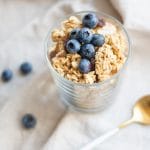 Granola is a deceptively-unhealthy food. While often marketed as a “health food” just 0.25 cup of granola often contains 200 or more calories and way too much sugar. Instead, choose muesli or a less-sweetened cereal like cheerios or grape nuts.
Granola is a deceptively-unhealthy food. While often marketed as a “health food” just 0.25 cup of granola often contains 200 or more calories and way too much sugar. Instead, choose muesli or a less-sweetened cereal like cheerios or grape nuts.
To make your breakfast even more nutritious (and higher in protein), eat cereal with plain Greek yogurt instead of milk.
6. Hash Browns ➡️ Fresh Fruit Salad
 Hash browns are the breakfast equivalent of french fries: fried, salted potato. One serving of hash browns at IHOP, for example, has 280 calories, 430 mg of sodium and 28 g of carbohydrate. Plus, at many restaurants, these potatoes are served as a side to carbs (e.g. pancakes, waffles, etc.), which is also served with bread. You don’t need that much starch. Instead, choose fresh fruit as your side!
Hash browns are the breakfast equivalent of french fries: fried, salted potato. One serving of hash browns at IHOP, for example, has 280 calories, 430 mg of sodium and 28 g of carbohydrate. Plus, at many restaurants, these potatoes are served as a side to carbs (e.g. pancakes, waffles, etc.), which is also served with bread. You don’t need that much starch. Instead, choose fresh fruit as your side!
7. Quiche ➡️ Frittata
 Traditional quiche is loaded with cream and cheese, plus uses a butter-rich pie crust as the base. One slice of standard quiche Lorraine (ham & cheese quiche) has around 450 calories and 35 grams of fat. Instead, make yourself a quick vegetable frittata!
Traditional quiche is loaded with cream and cheese, plus uses a butter-rich pie crust as the base. One slice of standard quiche Lorraine (ham & cheese quiche) has around 450 calories and 35 grams of fat. Instead, make yourself a quick vegetable frittata!
- Sauté about 1 cup of your favorite veggies (spinach, red peppers, mushrooms, onion, etc.)
- Add 2-3 eggs and mix until well combined
- Pour into an oven-safe dish and bake until a knife comes out clean
- Sprinkle cheese on top before serving, if you want
8. Orange Juice ➡️ Orange Slices
 The fruit and the juice both give you lots of beneficial vitamin C, but the fruit slices give you another important nutrient too: fiber. Fiber increases satiety, promotes digestive regularity and can help reduce cholesterol. Choose fruit over juice, when possible, to get the most nutritional bang for your buck.
The fruit and the juice both give you lots of beneficial vitamin C, but the fruit slices give you another important nutrient too: fiber. Fiber increases satiety, promotes digestive regularity and can help reduce cholesterol. Choose fruit over juice, when possible, to get the most nutritional bang for your buck.
Lighter Lunch & Dinner with Healthy Food Swaps
Out for lunch or dinner and debating what to order? Or hoping to healthify a homemade favorite? Check out these healthy food swaps to make lunch and dinner a little lighter.
9. Fried Chicken Thigh ➡️ Grilled Chicken Breast
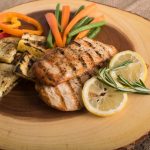 When deciding how to cook (or order) your meats, go for baked or grilled over fried or “crispy”. Better yet, when eating poultry, choose boneless/skinless for a leaner, more nutritious option. If you love dark meat and don’t want to switch to breasts, make your dish healthier by taking off the skin.
When deciding how to cook (or order) your meats, go for baked or grilled over fried or “crispy”. Better yet, when eating poultry, choose boneless/skinless for a leaner, more nutritious option. If you love dark meat and don’t want to switch to breasts, make your dish healthier by taking off the skin.
A boneless/skinless chicken breast has 165 calories, 31 grams of protein and 3.6 grams of fat. A skin-on drumstick, on the other hand, has 216 calories, 27 grams of protein and 11.2 grams of fat (and it’s a lot less meat!). That’s before you even count the calories from fried vs. grilled.
10. Lasagna ➡️ Spaghetti & Meatballs
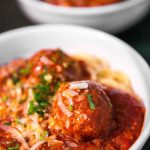 The cheese in lasagna makes it a much more caloric (and higher-fat) option than similar pasta dishes. So, if you’re looking for a healthy food swap for lasagna, you have two options:
The cheese in lasagna makes it a much more caloric (and higher-fat) option than similar pasta dishes. So, if you’re looking for a healthy food swap for lasagna, you have two options:
? Skip the noodles and make lasagna with zucchini or eggplant instead
? Skip the cheese and have spaghetti and meatballs instead
There’s no “right answer” about what to eat or not eat, so pick the swap that works best for you (and best satisfies your craving)!
11. Fried Rice ➡️ Beef & Broccoli
 When ordering at a Chinese restaurant, choose steamed or sautéed meat and vegetable entrees. Good options at a take-out Chinese restaurant include: beef & broccoli, shrimp & vegetables with black bean sauce, moo shu chicken/vegetables, kung pao chicken, lettuce wraps or anything steamed. Avoid anything fried or starch-based, especially as your entrée.
When ordering at a Chinese restaurant, choose steamed or sautéed meat and vegetable entrees. Good options at a take-out Chinese restaurant include: beef & broccoli, shrimp & vegetables with black bean sauce, moo shu chicken/vegetables, kung pao chicken, lettuce wraps or anything steamed. Avoid anything fried or starch-based, especially as your entrée.
To give you an idea of the difference: at Panda Express a entrée-sized portion of broccoli beef has only 150 calories, while a single side portion of fried rice has a whopping 520 calories!
12. Broccoli Cheddar Soup ➡️ Minestrone or Chicken Noodle Soup
 When choosing soup, favor broth-based soups over cream-based soups. Bisques, chowders and cheesy soups are generally heavier and more calorie-dense. Lower calorie options include: minestrone, chicken noodle, miso or any broth-based vegetable soup. If you’re eating canned soups, also take care to select options that are lower in sodium.
When choosing soup, favor broth-based soups over cream-based soups. Bisques, chowders and cheesy soups are generally heavier and more calorie-dense. Lower calorie options include: minestrone, chicken noodle, miso or any broth-based vegetable soup. If you’re eating canned soups, also take care to select options that are lower in sodium.
At Panera a bowl of chicken noodle soup is 160 calories, while a similar-sized serving of broccoli cheddar soup has 360 calories. That’s 200 calories difference in soup alone!
13. Hot Dogs, Bacon & Sausage ➡️ Fish or Chicken
 Eating processed meats – such as pepperoni, sausage, chorizo, ham, bacon or hot dogs – has been linked to an increased risk of bowel and stomach cancer. Minimize or entirely eliminate these foods in your diet. Red meat is better than processed meat, but should still be limited to no more than 3-4 servings per week to avoid increased risk of heart disease and cancer. Choose chicken, turkey, fish or seafood instead.
Eating processed meats – such as pepperoni, sausage, chorizo, ham, bacon or hot dogs – has been linked to an increased risk of bowel and stomach cancer. Minimize or entirely eliminate these foods in your diet. Red meat is better than processed meat, but should still be limited to no more than 3-4 servings per week to avoid increased risk of heart disease and cancer. Choose chicken, turkey, fish or seafood instead.
14. Normal Meat Pizza ➡️ Thin Crust Veggie Pizza
 Pizza gets a bad reputation for never being allowed as part of healthy diet, but it really just depends on how you order it. To make pizza healthier:
Pizza gets a bad reputation for never being allowed as part of healthy diet, but it really just depends on how you order it. To make pizza healthier:
- Choose thin crust or a vegetable crust (cauliflower or broccoli)
- Go easy on the cheese
- Top with vegetables and/or shredded chicken. Skip the processed meats
- Use marinara sauce as the base instead of BBQ sauce or white sauce
If you’re ordering takeout, go for thin crust veggie. Pizza Hut, one slice of a large Hand Tossed Meat Lover’s pizza has 390 calories, 21 grams of fat and 34 grams of carbohydrates. By comparison, one slice of a large Thin ‘n Crispy Veggie Lover’s has just 230 calories, 8 grams of fat and 31 grams of carbohydrates.
15. French Fries ➡️ Baked Potato
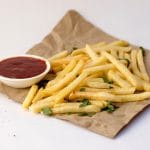 Enjoy your potato, but skip the fried version to maximize nutrition. Not only are baked potatoes much lower in calories and fat than french fries, but the skin is also a great source of iron. That’s just a bonus on top of the fiber, potassium and vitamins B and C contained in both the flesh and skin of the tuber. But don’t undo your healthy food swap by topping the potato with loads of cheese, bacon and butter… Instead, fill your baked potato with chili, beans, salsa, spices (cayenne, black pepper, etc.) and a small sprinkle of cheese.
Enjoy your potato, but skip the fried version to maximize nutrition. Not only are baked potatoes much lower in calories and fat than french fries, but the skin is also a great source of iron. That’s just a bonus on top of the fiber, potassium and vitamins B and C contained in both the flesh and skin of the tuber. But don’t undo your healthy food swap by topping the potato with loads of cheese, bacon and butter… Instead, fill your baked potato with chili, beans, salsa, spices (cayenne, black pepper, etc.) and a small sprinkle of cheese.
If you’re going through the drive-through at Wendy’s, consider that a medium fries has 420 calories and 19g of fat, while a sour cream & chives baked potato has just 310 calories and 3.5g of fat.
16. Soda or Sweet Tea ➡️ Water with Lemon
 A recent study linked daily soda consumption with a significantly higher risk of cardiovascular disease. This connection is strongest for women who drink regular soda, but drinking 4 or more diet drinks per day was also associated with an increased risk of cardiovascular disease.
A recent study linked daily soda consumption with a significantly higher risk of cardiovascular disease. This connection is strongest for women who drink regular soda, but drinking 4 or more diet drinks per day was also associated with an increased risk of cardiovascular disease.
Instead of soda or sweet tea, drink water to stay hydrated. If you don’t like the taste of water (or find it boring), add some lemon and/or mint. Herbal teas (e.g. mint or ginger) are also calorie-free, caffeine-free options that you sip-on to stay hydrated.
Healthy Food Swaps for Snacks & Desserts
Sometimes it’s not as much the meals as the snacks and desserts that prove problematic when we’re working hard to lose weight. So, if you want a little something extra, here are some healthy food swaps for popular snacks and desserts.
17. Chips ➡️ Carrots and Ranch
 Craving crunch? Pair baby carrots or sliced bell pepper with ranch. Or, if you want something with a little more protein (and a saltier flavor), try hummus.
Craving crunch? Pair baby carrots or sliced bell pepper with ranch. Or, if you want something with a little more protein (and a saltier flavor), try hummus.
A quarter cup (4 Tbsp) of store-bought hummus plus 15 baby carrots has about 150 calories and 5g of protein, plus lots of beneficial fiber and vitamin A. Compare that to a snack-sized (1oz) bag of Lays, which has a similar 160 calories, but no noteworthy amount of vitamins or fiber and a whopping 10g of total fat. The carrots and hummus will keep you fuller for longer, and serve you better in the long-run.
18. Microwave Popcorn ➡️ Air-Popped Popcorn
 Microwave popcorn has earned a bad reputation in the past couple of decades, mostly related to reports that chemicals used to package and flavor this popular snack are linked to cancer and other serious diseases. Manufacturers have now voluntarily removed the chemicals from their products, but they have been replaced with newer substances with yet-unknown consequences. As a result, many people still think it’s best to avoid this quick microwave snack.
Microwave popcorn has earned a bad reputation in the past couple of decades, mostly related to reports that chemicals used to package and flavor this popular snack are linked to cancer and other serious diseases. Manufacturers have now voluntarily removed the chemicals from their products, but they have been replaced with newer substances with yet-unknown consequences. As a result, many people still think it’s best to avoid this quick microwave snack.
Thankfully, popcorn itself is not the problem. Homemade popcorn is low in calories, high in fiber and versatile, and making it at home allows you to steer clear of the extra fat, additives and chemicals!
Simply mix ½ cup un-popped popcorn kernels with 1 tsp of vegetable oil, then pour coated kernels into a brown paper bag (like a lunch bag). Fold the bag over 2x to seal the top and then microwave it on high for 2.5 to 3 minutes. Voila! Easy, healthy microwave popcorn.
19. Granola Bar ➡️ Apple and Peanut Butter
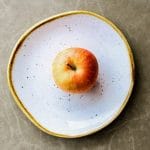 Granola bars are another one of those deceptively-unhealthy “health foods”. More often than not, these on-the-go snacks have over 10g of sugar per serving and not much else in terms of protein, fiber or vitamins. They may give you the calories you’re looking for, but they’re not contributing much else.
Granola bars are another one of those deceptively-unhealthy “health foods”. More often than not, these on-the-go snacks have over 10g of sugar per serving and not much else in terms of protein, fiber or vitamins. They may give you the calories you’re looking for, but they’re not contributing much else.
Instead, slice-up an apple and pair it with peanut butter for your between-meals snack. If you want to save calories, consider a peanut powder (like PB2) that contains all of the protein of peanut butter but has been pressed to take-out most of the oil (fat).
20. Ben & Jerry’s Ice Cream ➡️ Halo Top Ice Cream
 If you have a craving for ice cream but want to stick with your daily calorie goals, check out Halo Top ice creams. These low-calorie, high-protein desserts have just 280-320 calories per pint (70-80 calories per half cup), plus much less fat and sugar than traditional ice cream from brands like Haagan Dazs or Ben & Jerry’s. So, you can enjoy a scoop or two of ice cream without feeling guilty!
If you have a craving for ice cream but want to stick with your daily calorie goals, check out Halo Top ice creams. These low-calorie, high-protein desserts have just 280-320 calories per pint (70-80 calories per half cup), plus much less fat and sugar than traditional ice cream from brands like Haagan Dazs or Ben & Jerry’s. So, you can enjoy a scoop or two of ice cream without feeling guilty!
It’s worth noting, however, that some people believe that if you’re going to enjoy a scoop of ice cream you should just go for the real thing. Click here to read more about that debate.
21. Milk Chocolate ➡️ Dark Chocolate
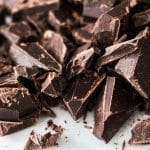 Dark chocolate is high in antioxidants, contains several beneficial minerals (manganese, copper, iron, magnesium, potassium, phosphorous, zinc and selenium) and dietary fiber, and even boasts a surprisingly healthy fatty acid profile. It’s not surprising, then, that this bitter chocolate is said to produce a wide variety of health benefits.
Dark chocolate is high in antioxidants, contains several beneficial minerals (manganese, copper, iron, magnesium, potassium, phosphorous, zinc and selenium) and dietary fiber, and even boasts a surprisingly healthy fatty acid profile. It’s not surprising, then, that this bitter chocolate is said to produce a wide variety of health benefits.
To reap these benefits of this swap, choose chocolate with a minimum of 70-80% cocoa. “Dark chocolate” with 50-60% cocoa is more nutritionally similar to not-so-healthy milk chocolate, which is significantly higher in fat and sugar than dark chocolate.
Healthy Food Swaps for Condiments & Dips
Condiments and sauces can be a major source of diet-destroying calories. Still, food without sauces can get very boring very quickly. So, try-out these healthy food swaps to flavor your food more nutritiously!
22. White Sauce ➡️ Red Sauce
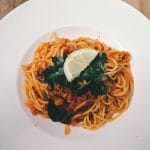 Next time you make pasta, pizza, zoodles or need a dip for breadsticks, opt for marinara. White sauces like alfredo and carbonara are made with cream, which makes them highly caloric. Red sauces, on the other hand are little more than tomatoes, water/broth and spices. So, if your goal is weight loss, swap the white sauces for a red sauce like marinara.
Next time you make pasta, pizza, zoodles or need a dip for breadsticks, opt for marinara. White sauces like alfredo and carbonara are made with cream, which makes them highly caloric. Red sauces, on the other hand are little more than tomatoes, water/broth and spices. So, if your goal is weight loss, swap the white sauces for a red sauce like marinara.
By swapping Ragu Alfredo Sauce for Ragu Tomato & Basil sauce, you’ll save 30 calories per half cup (60 vs. 90 calories). Red sauce is also much lower in fat. So, if your goal is weight loss, swap the white sauces for a red sauce like marinara.
23. Sour Cream ➡️ Fat-Free, Plain Greek Yogurt

Want a creamy topper for your tacos, chili or baked potato? Swap plain Greek yogurt in for sour cream.
A typical serving of regular sour cream (about 2 Tbsp) has 45 calories and 5g of fat. That same amount of plain, non-fat Greek yogurt has 15 calories, no fat and 2.75g of natural protein.
24. Queso Dip ➡️ Salsa

Going out for Mexican food? Take it easy on the free chips and go for salsa instead of queso. Just because you’re on a diet doesn’t mean you can’t enjoy any chips, but it does mean you should indulge smarter. Keep in-mind that 1oz of tortilla chips (about 9 chips) has around 140 calories. A quarter cup of salsa only has 15-20 calories, whereas that same about of queso dip has 80+ calories. Salsa is also fat-free.
If you love the dips and aren’t as attached to the chips, swap tortilla chips for veggies (carrots, bell peppers, cucumber, etc.) and enjoy the dips without the added calories of the chips!
25. Mayonnaise ➡️ Mustard
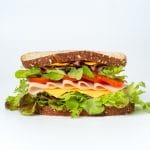
Swap mustard for mayonnaise on sandwiches and wraps. Mayonnaise is mainly fat, so it’s highly caloric at a shocking 95 calories and 10g of fat per tablespoon. And lots of us use a lot more than 1 Tbsp of mayo on the average sandwich.
Instead, slather your sandwich with as much mustard as you want. One packet (1 tsp) of mustard has only 3 calories and almost no fat. If you don’t like traditional yellow mustard, experiment with Dijon or spicy brown mustard.
26. Caesar Dressing ➡️ Italian Dressing
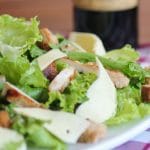
Salads are an inherently healthy food, but people sometimes make them unhealthy by piling the lettuce high with high-calorie, high-fat and or high-sugar toppings. As you build (or order) a green salad, make it more diet friendly by:
- Swapping creamy dressings (Caesar, blue cheese) for vinaigrettes (Italian, oil & vinegar)
- Taking it easy on the cheese and bread (croutons)
- Using grilled, not breaded, meats
Using these healthy food swaps, you’ll be able to make your favorite everyday meals healthier little by little! Small savings add-up, so if you consistently swap-out less healthy options for healthier alternatives you’ll notice that the weight starts coming off slowly, but surely!
Do you have any other healthy food swaps that you use to make every day meals healthier? Share them with us in the comments section below!







I love granola, I don’t get what it gets such a bad rep. it’s all about portion control.
Hey Andy! Yes, great point. I think it has a bad reputation because most people don’t just eat the recommended 1/4 cup per serving. It’s more like a topping than a cereal!
Zack, HTLW team
I appreciate this… it can be hard to know what to snack on when you’re trying to limit your calories.
Glad you enjoyed it, Ian! Thanks for reading.
Zack, HTLW team
I really really like this, I think I should print it!
Yay, we’re so glad you enjoyed it!
Rachel, HTLW team